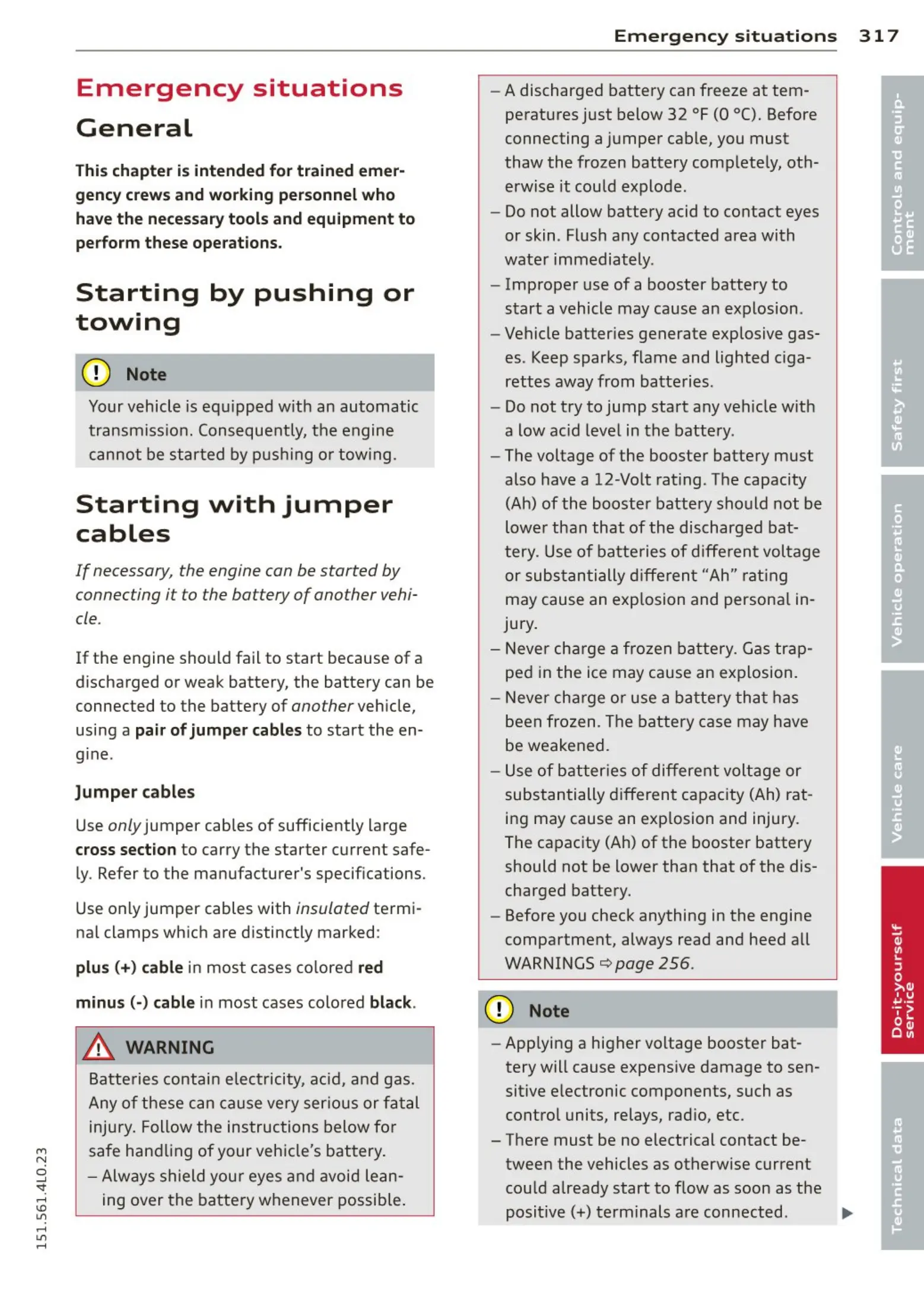M
N
0
...J
'SI:
,....,
\!)
..,.,
,....,
..,.,
,....,
Emergency situations
General
This chapter is intended for trained emer-
gency crews and working personnel who
have the necessary tools and equipment to
perform these operations.
Starting by pushing or
towing
(D Note
Your vehicle is equi pped with an automatic
tra nsmiss ion. Conseque nt ly, the e ngine
cann ot be started by pus hing o r tow ing.
Starting with jumper
cables
If necessary, the engine can be started by
connecting it to the battery of another vehi-
cle.
If t he engine shou ld fail to start because of a
discharged or weak battery, the battery can be
connected to the battery of
another veh icle,
usi ng a pair of jumper cables to start the en-
gine .
Jumper ca bles
Use only jumper cab les of sufficiently large
cross section to carry the starter cur rent safe-
ly. Refer to the man ufacturer's specifications.
Use only jumper cables with
insulated te rm i-
na l clamps which are distinctly mar ked:
plus(+ ) cable in mos t cases colore d red
minus(-) cable
in most cases colored black .
A WARNING
Batt e ries con t ain e lectr icity, a cid, and gas.
Any of t hese can caus e very ser ious or fata l
injury . Follow the instruc t ions below fo r
safe han dli ng of your veh icle's battery .
- Always s hield your eyes and avoid lean-
ing over t he bat te ry whenever possib le.
Emergency situations 31 7
- A discharged battery can freeze at tem-
pe rat ures just below 32 °F (0 °C). Before
connecting a ju mpe r cable, you must
thaw the frozen battery comp lete ly, ot h-
e rwise it could explode.
- Do not allow battery acid to contact eyes
or skin . Flush any cont acted area wit h
wat er immediately .
- Imp roper use of a booster battery to
st art a vehicle may cause an explosion.
- Vehicle batter ies generate expl osive gas-
es. Keep sparks, flame and lighted ciga-
rettes away from bat te ries.
- Do not t ry to jump start a ny ve hicle wit h
a low ac id leve l in the battery.
- The voltage of the booste r batte ry m ust
also have a 12-Volt rat ing. The capac ity
(Ah) of the booste r batt e ry sho uld not be
lowe r than that of th e discharged bat-
t ery. Use of batt e ries of d iffe ren t volt age
or subst an t ially differen t "Ah" rat ing
may cause an exp losion and pers onal in-
jury .
- Never charg e a frozen batt ery. Gas t ra p-
ped in t he ice may cau se an explosion .
- Neve r char ge o r use a batt e ry t hat has
been frozen . The batte ry case may have
be weake ned.
- Use of bat t er ies of differe nt volta ge or
substantially diffe ren t capacity (Ah) rat -
ing may cause an exp losion and injury .
The ca pa city (Ah) of the booster battery
should not be lower than that of t he dis-
charged battery.
- Before you check anything in the engine
compa rtment, always read an d heed a ll
WARNINGS¢
page 256.
(D Note
- App lying a high er voltage booste r bat -
t ery will cause expens ive damage to sen -
sit ive e lectronic components, such as
cont rol units, relays, rad io, etc.
- There must be no electrical contact be -
tween the vehicles as otherw ise current
could already start to f low as soon as t he
posi ti ve(+) terminals a re con nect ed. ..,.
•
•

